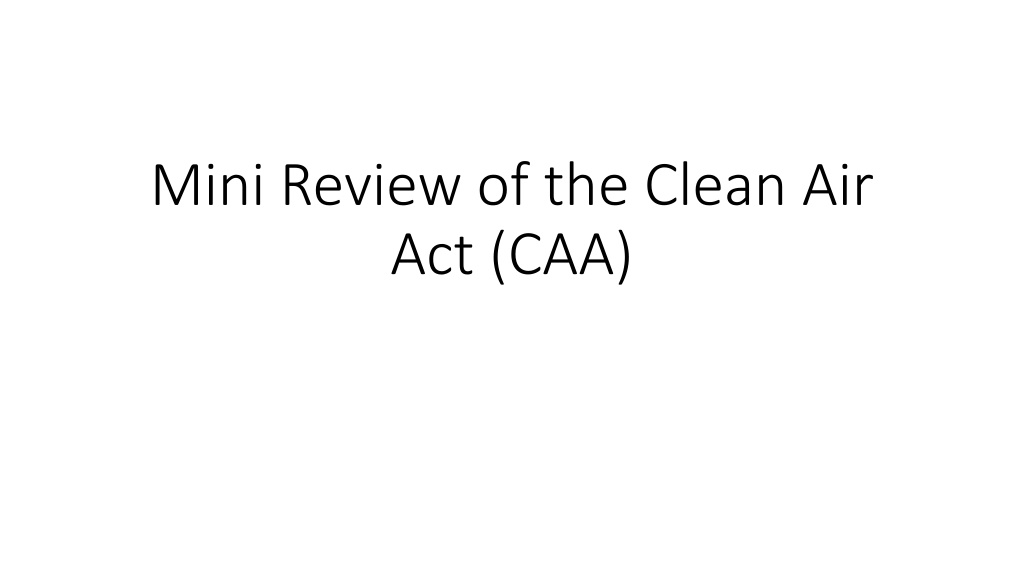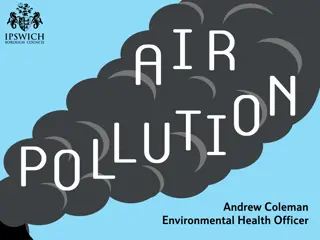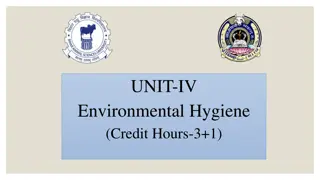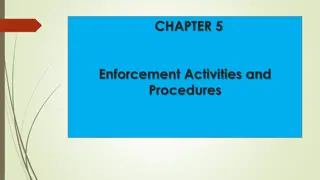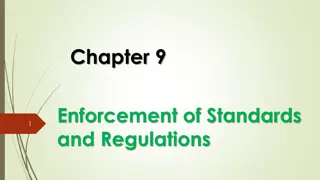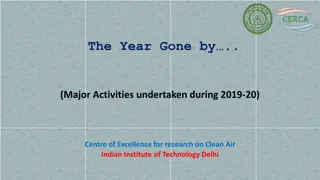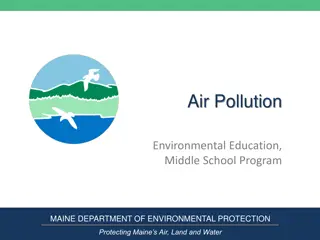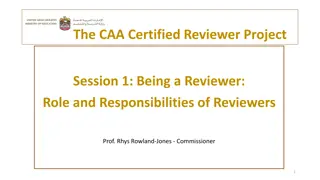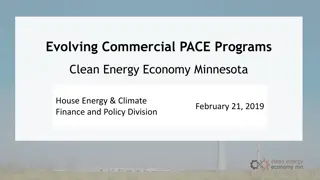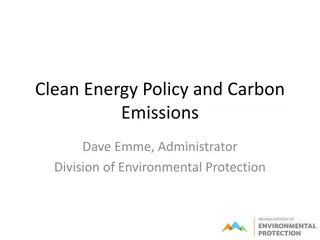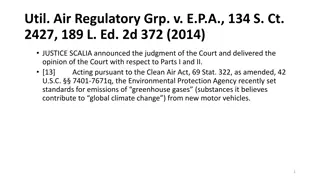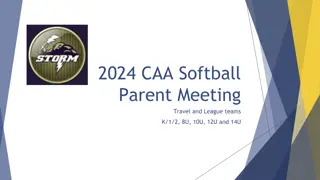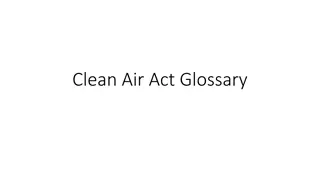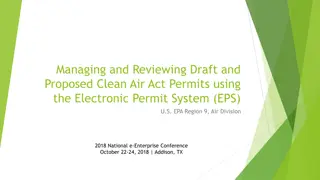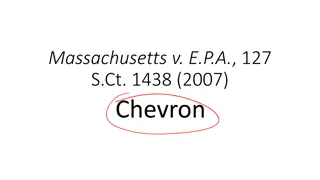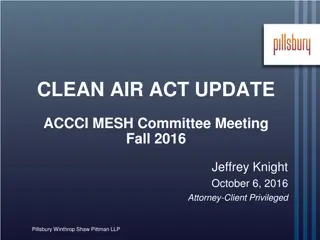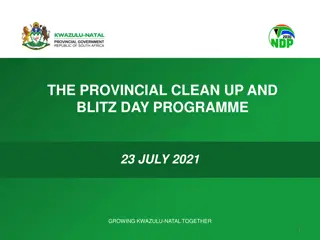Overview of the Clean Air Act (CAA) and Its Impact
The Clean Air Act (CAA) was established to protect human health by regulating pollution levels in different zones. It contains provisions for both stationary and mobile sources, addressing emissions from factories, power stations, and cars. The Act aims to balance environmental protections with cost considerations, with later amendments extending protections to nature. Key cases and opinions such as Massachusetts v. E.P.A. and the Cannon Memo have influenced the implementation of the CAA over the years.
Download Presentation

Please find below an Image/Link to download the presentation.
The content on the website is provided AS IS for your information and personal use only. It may not be sold, licensed, or shared on other websites without obtaining consent from the author.If you encounter any issues during the download, it is possible that the publisher has removed the file from their server.
You are allowed to download the files provided on this website for personal or commercial use, subject to the condition that they are used lawfully. All files are the property of their respective owners.
The content on the website is provided AS IS for your information and personal use only. It may not be sold, licensed, or shared on other websites without obtaining consent from the author.
E N D
Presentation Transcript
Mini Review of the Clean Air Act (CAA)
Purpose of the Original CAA Was to Protect Human Health The country is divided into attainment zones and the level of pollution is determined in each zone. The agency has broad authority to decide what to regulate. The agency is limited because the CAA is based on cost/benefit. Regulations are not intended to change business practices, just clean them up. Exception for very toxic emissions. The act is divided into stationary and mobile sources. Later amendments included protections for nature that were not based on local effects. Acid rain regs. These look more like GHG regs, but are not structurally part of the CAA.
Stationary Sources Factories, power stations, etc. Defined by not moving and by For most pollutants, the amount that can be emitted is based on the existing local concentrations of the pollutants. The objective is to keep the total local pollutant level below the threshold for human health effects. Thus, emissions regulations can differ among locations. There are provisions to limit degradation you do not get unlimited emissions in pristine locations. This is a problem for GHGs, which have no local effect.
Mobile Sources Mostly cars. Since they move, emissions are not tied to local health effects but are set to a national standard that protects all communities to some extent, while not being too costly. California was allowed to have more strict standards because it was already regulating car emissions when the CAA was passed. Many states also adopt California standards, which then dominate the industry. The Trump administrative limited the California exception, which has been restored. Fits GHGs better. Primary controls for GHGs are increasing milage and shifting fuels.
Massachusetts v. E.P.A., 549 U.S. 497 (2007) Standing Majority Opinion Mobile Source Case
The Cannon (EPA General Counsel) Memo - 1998 This opinion was prepared in response to a request from Congressman DeLay As this opinion discusses, the Clean Air Act provides EPA authority to address GHGs as air pollution, and a number of specific provisions of the Act are potentially applicable to control these pollutants from electric power generation. Clinton EPA 6
5 U.S. Code 553 Petition for Rulemaking (e) Each agency shall give an interested person the right to petition for the issuance, amendment, or repeal of a rule. 7
What did the Petition of October 20, 1999 ask the EPA to do? On October 20, 1999, a group of 19 private organizations filed a rulemaking petition asking EPA to regulate "greenhouse gas emissions from new motor vehicles under 202 of the Clean Air Act." As to EPA's statutory authority, the petition observed that the agency itself had already confirmed that it had the power to regulate carbon dioxide. The Clinton EPA sat on the petition to run out the clock. 8
When Did EPA Seek Public Comment on the Petition? The Bush II EPA still had to address the petition. Bush II had said he would regulate GHGs. [45] Fifteen months after the petition's submission, EPA requested public comment on "all the issues raised in [the] petition," adding a "particular" request for comments on "any scientific, technical, legal, economic or other aspect of these issues that may be relevant to EPA's consideration of this petition." 66 Fed. Reg. 7486, 7487 (2001). 9
What was EPAs Response to the Petition? On September 8, 2003, EPA entered an order denying the rulemaking petition. 68 Fed. Reg. 52922. The agency gave two reasons for its decision: (1) that contrary to the opinions of its former general counsels, the Clean Air Act does not authorize EPA to issue mandatory regulations to address global climate change, and (2) that even if the agency had the authority to set greenhouse gas emission standards, it would be unwise to do so at this time. By questioning its authority, the EPA is inviting the Court to second guess its decision the court is the final decider on what statutes and the Constitution mean. 10
5 U.S. Code 704 - Actions reviewable Agency action made reviewable by statute and final agency action for which there is no other adequate remedy in a court are subject to judicial review. A preliminary, procedural, or intermediate agency action or ruling not directly reviewable is subject to review on the review of the final agency action. Except as otherwise expressly required by statute, agency action otherwise final is final for the purposes of this section whether or not there has been presented or determined an application for a declaratory order, for any form of reconsideration, or, unless the agency otherwise requires by rule and provides that the action meanwhile is inoperative, for an appeal to superior agency authority. The denial of the petition is a final agency action.
5 U.S. Code 706 - Scope of review To the extent necessary to decision and when presented, the reviewing court shall decide all relevant questions of law, interpret constitutional and statutory provisions, and determine the meaning or applicability of the terms of an agency action. The reviewing court shall (1)compel agency action unlawfully withheld or unreasonably delayed; and (2)hold unlawful and set aside agency action, findings, and conclusions found to be (A)arbitrary, capricious, an abuse of discretion, or otherwise not in accordance with law; (B)contrary to constitutional right, power, privilege, or immunity; (C)in excess of statutory jurisdiction, authority, or limitations, or short of statutory right; (D)without observance of procedure required by law; (E)unsupported by substantial evidence in a case subject to sections 556 and 557 of this title or otherwise reviewed on the record of an agency hearing provided by statute; or (F)unwarranted by the facts to the extent that the facts are subject to trial de novo by the reviewing court. In making the foregoing determinations, the court shall review the whole record or those parts of it cited by a party, and due account shall be taken of the rule of prejudicial error.
Standing to Challenge the Reply to the Petition Requesting Rulemaking.
The Case and Controversy Question EPA maintains that because greenhouse gas emissions inflict widespread harm, the doctrine of standing presents an insuperable jurisdictional obstacle. No standing, no case and controversy. 15
The Lujan Standard for Standing First, the plaintiff must have suffered an "injury in fact" -- an invasion of a legally-protected interest which is (a) concrete and particularized, and (b) "actual or imminent, not 'conjectural' or 'hypothetical,'" Second, there must be a causal connection between the injury and the conduct complained of -- the injury has to be "fairly . . . traceable to the challenged action of the defendant, and not . . . the result [of] the independent action of some third party not before the court." Third, it must be "likely," as opposed to merely "speculative," that the injury will be "redressed by a favorable decision." Justice Scalia plaintiffs denied standing. 16
How is Particularized Injury Related to Case and Controversy? "While it does not matter how many persons have been injured by the challenged action, the party bringing suit must show that the action injures him in a concrete and personal way. This requirement is not just an empty formality. It preserves the vitality of the adversarial process by assuring both that the parties before the court have an actual, as opposed to professed, stake in the outcome, and that the legal questions presented ... will be resolved, not in the rarified atmosphere of a debating society, but in a concrete factual context conducive to a realistic appreciation of the consequences of judicial action." 504 U. S., at 581 (Lujan) 17
Lujan Relaxed Standing Requirements for Procedural Rights Cases In Lujan v. Defenders of Wildlife, the Court said, [t]he person who has been accorded a procedural right to protect his concrete interests can assert that right without meeting all the normal standards for redressability and immediacy. Mass v. EPA quoting Lujan. 18
Is this a Procedural Rights Case? What are the petitioners seeking from the court? An order forcing the EPA to make a rule? An order that the EPA must reconsider its answer based on having the authority to regulate GHGs? If the Court finds that the EPA has the authority to regulate GHGs, does this require the EPA to make the rule? Plaintiffs are only asking for a procedural remedy. 19
What did Lujan Require for Standing in a Procedural Rights Case? There is this much truth to the assertion that "procedural rights" are special: The person who has been accorded a procedural right to protect his concrete interests can assert that right without meeting all the normal standards for redressability and immediacy. Thus, under our case-law, one living adjacent to the site for proposed construction of a federally licensed dam has standing to challenge the licensing agency's failure to prepare an Environmental Impact Statement, even though he cannot establish with any certainty that the Statement will cause the license to be withheld or altered, and even though the dam will not be completed for many years. 20
Does Petitioner have to Prove EPA Would Issue a Rule if its Prevails? "A [litigant] who alleges a deprivation of a procedural protection to which he is entitled never has to prove that if he had received the procedure the substantive result would have been altered. All that is necessary is to show that the procedural step was connected to the substantive result" Sugar Cane Growers Cooperative of Fla. v. Veneman, 289 F. 3d 89, 94-95 (CADC 2002) (Mass v. EPA) 21
Does Massachusetts Have Special Standing Rights? Stevens starts the standing analysis with this quote: "This is a suit by a State for an injury to it in its capacity of quasi- sovereign. In that capacity the State has an interest independent of and behind the titles of its citizens, in all the earth and air within its domain. It has the last word as to whether its mountains shall be stripped of their forests and its inhabitants shall breathe pure air." Georgia v. Tennessee Copper Co., 206 U. S. 230, 237 (1907) No one cited this case in the briefs or the lower court litigation. 22
What Does it Mean to Say that the State is acting as What Does it Mean to Say that the State is acting as Parens Patriae Parens Patriae? ? Parens patriae Parens patriae acting to protect as a parent. acting to protect as a parent. "One helpful indication in determining whether an "One helpful indication in determining whether an alleged injury to the health and welfare of its citizens alleged injury to the health and welfare of its citizens suffices to give the State standing to sue suffices to give the State standing to sue parens is whether the injury is one that the State, if it could, is whether the injury is one that the State, if it could, would likely attempt to address through its sovereign would likely attempt to address through its sovereign lawmaking powers". lawmaking powers". parens patriae patriae 23
Why Cant Massachusetts Protect its Citizens Itself? When a State enters the Union, it surrenders certain sovereign prerogatives. Massachusetts cannot invade Rhode Island to force reductions in greenhouse gas emissions, it cannot negotiate an emissions treaty with China or India, and in some circumstances the exercise of its police powers to reduce in-state motor-vehicle emissions might well be pre-empted. 24
Nature of the Injury Key Standing Question EPA argues that the injury is the direct effect of greenhouse gases - a warming planet which is not particularized. Petitioners argue it is the myriad effects of warming and ocean acidification. Loss of land from sea level rise on the coasts. Drought and fire in the west. Destruction of infrastructure by melting permafrost in Alaska. Destruction of fisheries by acidification. Each area suffers unique damages, which allow each area to claim a particularized injury. 25
Massachusetts Injury Claims Because the Commonwealth "owns a substantial portion of the state's coastal property," it has alleged a particularized injury in its capacity as a landowner. The severity of that injury will only increase over the course of the next century: If sea levels continue to rise as predicted, one Massachusetts official believes that a significant fraction of coastal property will be "either permanently lost through inundation or temporarily lost through periodic storm surge and flooding events. The state is also asserting this right for its residents. 26
Causation EPA does not dispute the existence of a causal connection between man-made greenhouse gas emissions and global warming. At a minimum, therefore, EPA's refusal to regulate such emissions "contributes" to Massachusetts' injuries. EPA nevertheless maintains that its decision not to regulate greenhouse gas emissions from new motor vehicles contributes so insignificantly to petitioners' injuries that the agency cannot be haled into federal court to answer for them. 27
Effect of Reducing CAFE on Projected 3.5C Warming by 2100 (Proposed Rule) 28
Must the Regulation Fix the Problem? But EPA overstates its case. Its argument rests on the erroneous assumption that a small incremental step, because it is incremental, can never be attacked in a federal judicial forum. Yet accepting that premise would doom most challenges to regulatory action. Agencies, like legislatures, do not generally resolve massive problems in one fell regulatory swoop. Is this the right question for the procedural rights case? 29
Redressability While it may be true that regulating motor-vehicle emissions will not by itself reverse global warming, it by no means follows that we lack jurisdiction to decide whether EPA has a duty to take steps to slow or reduce it. "[A] plaintiff satisfies the redressability requirement when he shows that a favorable decision will relieve a discrete injury to himself. He need not show that a favorable decision will relieve his every injury". Keep in mind that we are talking about a proper answer to the petition, not requiring a rule. 30
The Delay Between Regulations and Reducing Warming Because of the enormity of the potential consequences associated with man-made climate change, the fact that the effectiveness of a remedy might be delayed during the (relatively short) time it takes for a new motor-vehicle fleet to replace an older one is essentially irrelevant. 31
What about Other Countries? Nor is it dispositive that developing countries such as China and India are poised to increase greenhouse gas emissions substantially over the next century: A reduction in domestic emissions would slow the pace of global emissions increases, no matter what happens elsewhere. 32
The Standing Facts for Massachusetts In sum -- at least according to petitioners' uncontested affidavits -- the rise in sea levels associated with global warming has already harmed and will continue to harm Massachusetts. The risk of catastrophic harm, though remote, is nevertheless real. That risk would be reduced to some extent if petitioners received the relief they seek. We therefore hold that petitioners have standing to challenge the EPA's denial of their rulemaking petition. 33
Massachusetts v. E.P.A., 127 S.Ct. 1438 (2007) Standing - The Dissent
Does the Dissent Deny Climate Change? Global warming may be a "crisis," even "the most pressing environmental problem of our time. Indeed, it may ultimately affect nearly everyone on the planet in some potentially adverse way, and it may be that governments have done too little to address it. 35
Is it Being Ignored by the Government? It is not a problem, however, that has escaped the attention of policymakers in the Executive and Legislative Branches of our Government, who continue to consider regulatory, legislative, and treaty-based means of addressing global climate change. 36
Should States Get Special Treatment? Before determining whether petitioners can meet this familiar [standing] test, however, the Court changes the rules. It asserts that "States are not normal litigants for the purposes of invoking federal jurisdiction," and that given "Massachusetts' stake in protecting its quasi-sovereign interests, the Commonwealth is entitled to special solicitude in our standing analysis." 37
The Tennessee Copper Case [Tennessee Copper involved pollution drifting across the state line and damaging farms in Georgia. Georgia filed suit on behalf of the its landowners.] In contrast to the present case, there was no question in Tennessee Copper about Article III injury. . . . There was certainly no suggestion that the State could show standing where the private parties could not; there was no dispute, after all, that the private landowners had "an action at law." 38
What about State Owned Land as Supporting Its Special Status? What is more, the Court's reasoning falters on its own terms. The Court asserts that Massachusetts is entitled to "special solicitude" due to its "quasi-sovereign interests," but then applies our Article III standing test to the asserted injury of the State's loss of coastal property. In the context of parens patriae standing, however, we have characterized state ownership of land as a "nonsovereign interes[t]" because a State "is likely to have the same interests as other similarly situated proprietors." 39
The State as Parens Patria versus the Federal Government As a general rule, we have held that while a State might assert a quasi-sovereign right as parens patriae "for the protection of its citizens, it is no part of its duty or power to enforce their rights in respect of their relations with the Federal Government. In that field it is the United States, and not the State, which represents them." Massachusetts v. Mellon, 262 U. S. 447, 485-486 (1923) 40
The Majoritys Reliance on Tennessee Copper All of this presumably explains why petitioners never cited Tennessee Copper in their briefs before this Court or the D. C. Circuit. It presumably explains why not one of the legion of amici supporting petitioners ever cited the case. And it presumably explains why not one of the three judges writing below ever cited the case either. Given that one purpose of the standing requirement is " `to assure that concrete adverseness which sharpens the presentation of issues upon which the court so largely depends for illumination,' it is ironic that the Court today adopts a new theory of Article III standing for States without the benefit of briefing or argument on the point. 41
The Redressability Problem The injury the Court looks to is the asserted loss of land. But even if regulation does reduce emissions -- to some indeterminate degree, given events elsewhere in the world -- the Court never explains why that makes it likely that the injury in fact -- the loss of land -- will be redressed. Schoolchildren know that a kingdom might be lost "all for the want of a horseshoe nail," but "likely" redressability is a different matter. The realities make it pure conjecture to suppose that EPA regulation of new automobile emissions will likely prevent the loss of Massachusetts coastal land. 42
What Happened in the SCRAP Case? In SCRAP, the Court based an environmental group's standing to challenge a railroad freight rate surcharge on the group's allegation that increases in railroad rates would cause an increase in the use of nonrecyclable goods, resulting in the increased need for natural resources to produce such goods. According to the group, some of these resources might be taken from the Washington area, resulting in increased refuse that might find its way into area parks, harming the group's members. 43
What Does the Dissent Think of SCRAP? Over time, SCRAP became emblematic not of the looseness of Article III standing requirements, but of how utterly manipulable they are if not taken seriously as a matter of judicial self-restraint. SCRAP made standing seem a lawyer's game, rather than a fundamental limitation ensuring that courts function as courts and not intrude on the politically accountable branches. Today's decision is SCRAP for a new generation 44
What Does the Dissent Predict About the Future of the Majority s Position? The good news is that the Court's "special solicitude" for Massachusetts limits the future applicability of the diluted standing requirements applied in this case. The bad news is that the Court's self-professed relaxation of those Article III requirements has caused us to transgress "the proper -- and properly limited -- role of the courts in a democratic society." 45
